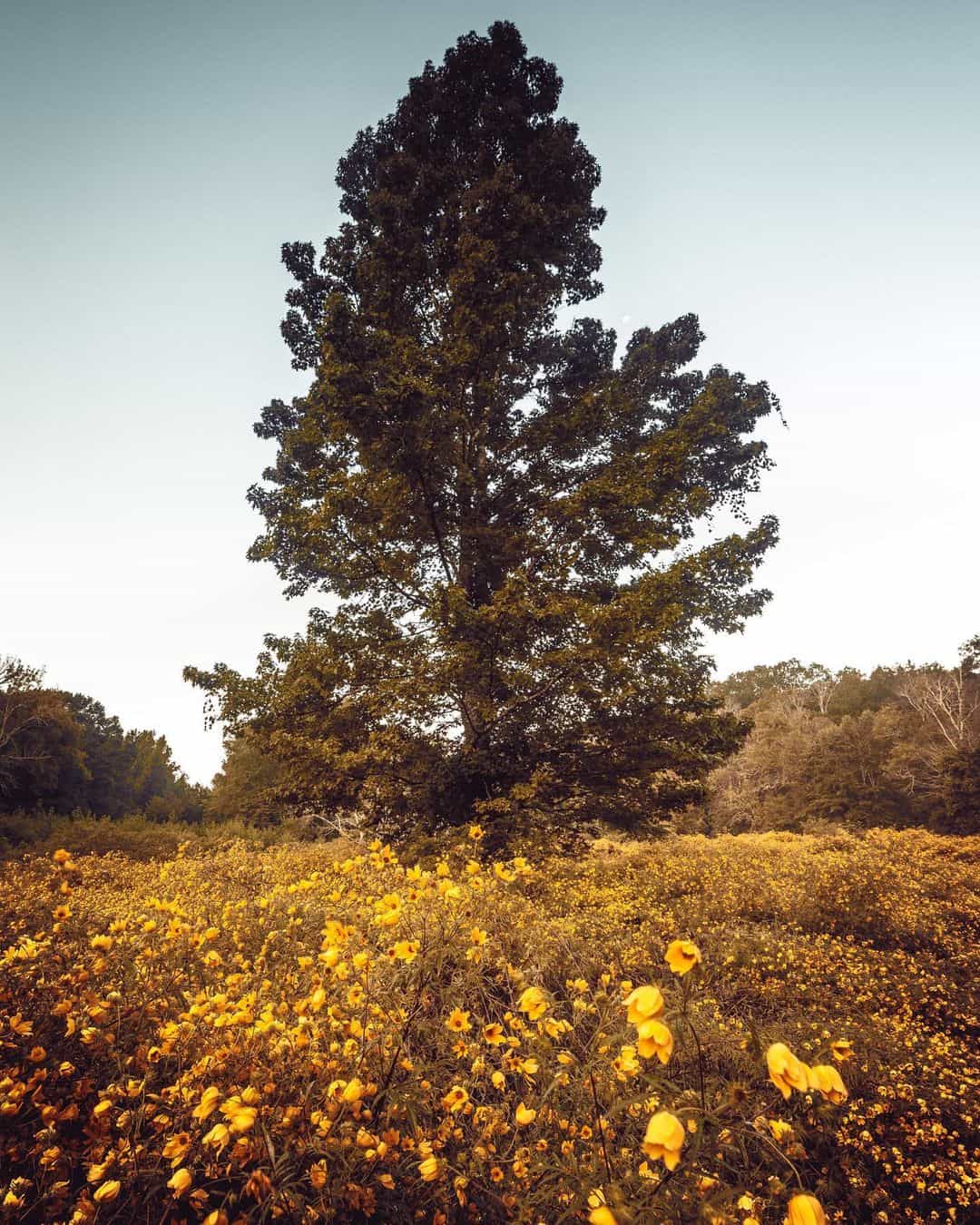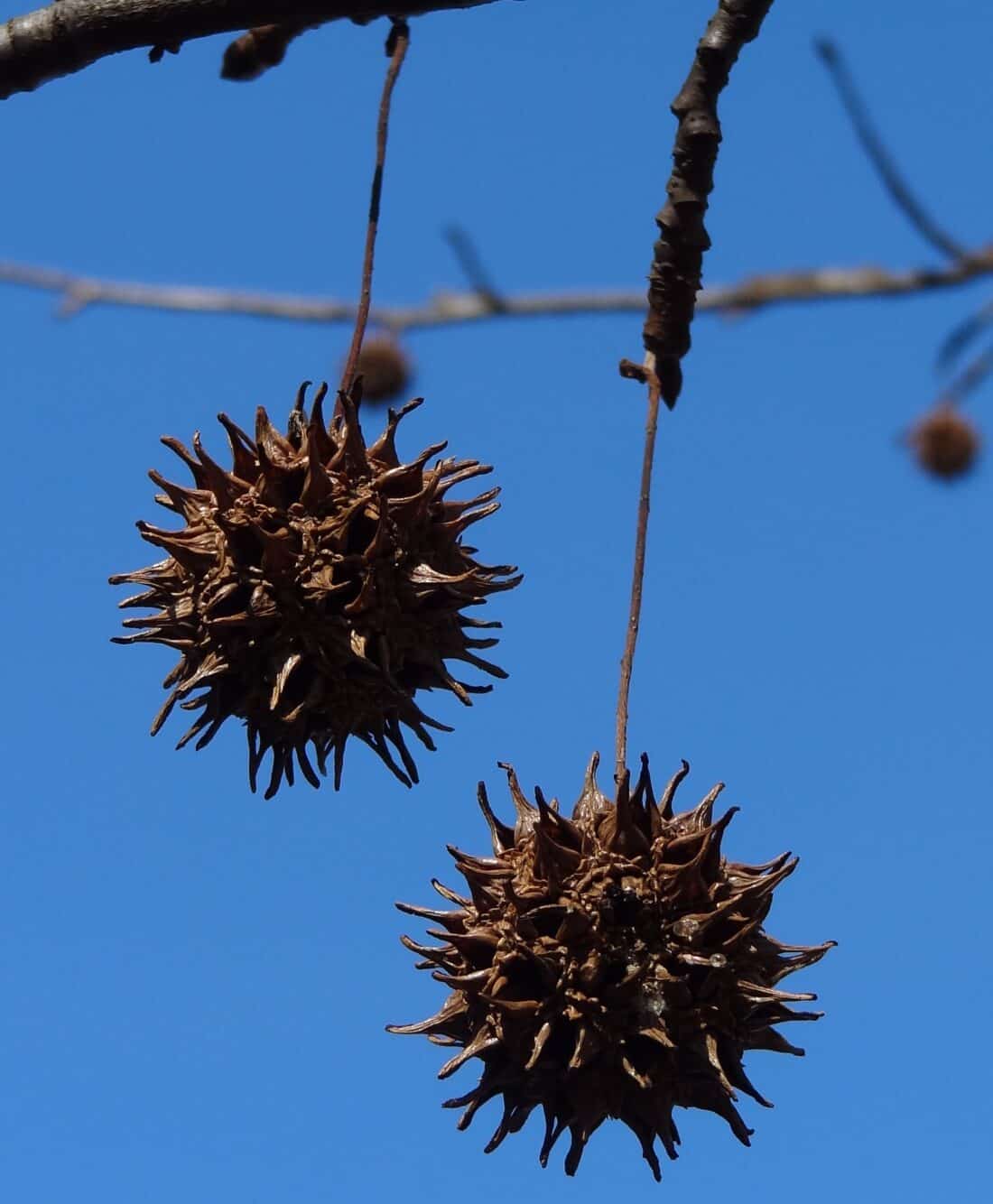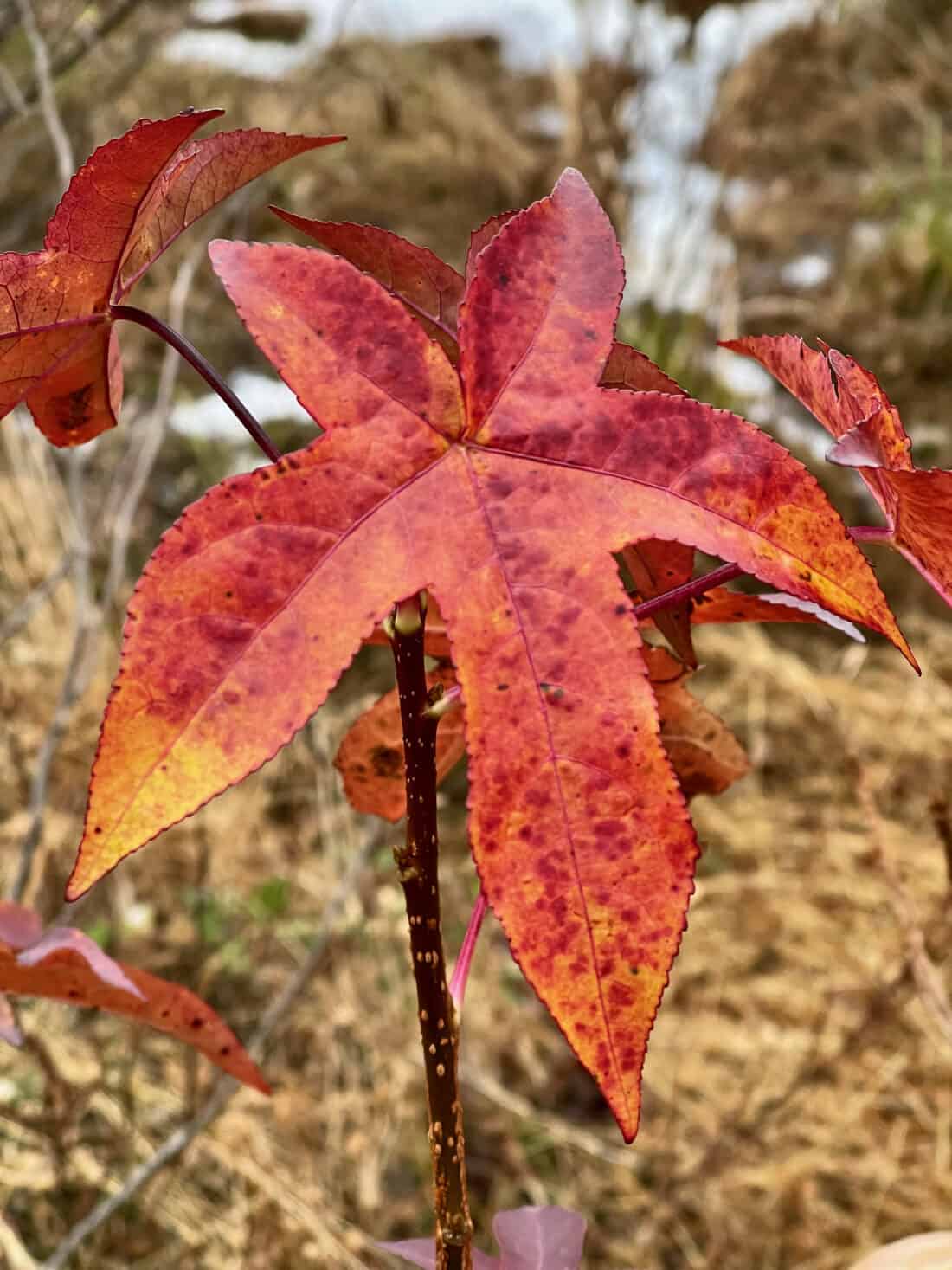As a Northeasterner, I’m used to seeing sugar maples dominate the forests near my home. They’re culturally loaded trees—beloved for their syrup, iconic on the Canadian flag, and synonymous with fall color. But in the Southeastern U.S., the Liquidambar styraciflua—also known as the American sweetgum tree—fills a similar niche. And honestly? It’s every bit as interesting, beautiful, and useful.

Identifying Native Sweetgum Trees
Sweetgum’s two most unique traits? Its resinous sap and its infamous fruit—the spiky, spherical seed capsules affectionately (or not) known as “gumballs.” These hard, burr-like pods drop in fall and winter and are impossible to miss underfoot. You might also hear them called “monkey balls.”
It is not however because of their spiky, spherical fruit capsules (though you might think that is the reason). Rather, when the bark is damaged, the sap runs out, creating balls on the tree that can be plucked off and chewed.
Despite their nickname, gumballs aren’t sweet—just less bitter than those of the nearby black gum tree (Nyssa sylvatica). This fragrant, amber-colored resin can be chewed like gum and has been used in traditional medicine and perfumery.
In summer, sweetgum leaves are a rich glossy green. Come fall, they blaze in shades of red, orange, purple, and gold—sometimes all on the same tree. The star-shaped leaves (usually with five lobes) are one of the easiest ways to ID this tree.
If you squint your eyes, the sweet gum could (especially at some times of the year) almost pass for a sugar maple with its similar leaves.
Crafters and decorators often use dried sweet gum fruit capsules in wreaths and other decorative arrangements. You might also notice Sweet gum balls in potpourri – they have a mild scent, but because of their texture, they make a lovely natural arrangement. Kids play with them (they are great for slingshots and imagination games). They can also be painted, dyed, or coated in glitter to create unique ornaments and decorations.
Sweetgum is one of the most important commercial hardwoods in the southeast. It is used for everything from fine furniture and cabinets to veneer to pulpwood and railroad ties. The wood is handsome and known for its distinctive pinkish-brown color and grain patterns. It is also a moderate to fast-growing deciduous tree that prefers wet bottomlands.
Liquidambar styraciflua – Wildlife Pollinator supporter
Consider growing Liquidambar styraciflua in your landscape as an excellent native shade tree that will also support a variety of wildlife, including small mammals like gray squirrels, beavers, and chipmunks.

A vast selection of birds eat the sweetgum seeds. (Goldfinches, purplefinches, mallard ducks, wood duck, bobwhite quails, Carolina chickadees and wrens, yellow-bellied sapsuckers, white-throated sparrows, towhees, sparrows, mourning doves, wild turkeys, and northern bobwhite.) In the spring, its female flowers are a food source for ruby-throated hummingbirds and other nectar feeders.
It is also a larval host for over thirty species of butterflies, the Promethea moth and the beautiful Luna moth.
If you have a tree nearby, you can collect the seed balls to make bird feeders. Fill a suet cage or mesh bag with peanut butter and roll it in crushed sweet gum balls to create a natural bird feeder that birds can cling to.
Growing Sweetgum in your Landscape
Sweetgum is widely planted as an ornamental, especially outside its natural range, due to its brilliant fall foliage (usually red).
Its fast growth and wide tolerance make it a good street, shade, and windbreak tree choice. Sweetgum is a lovely specimen tree paired with a green lawn playing background to its beautiful fall color. (It is shade intolerant, needing full sun and the ability to become the large overstory and excellent shade tree it is meant to be.)
The sweet gum is native to the southeastern United States and Mexico. But, its range extends into the midwest and along the coast of the eastern United States. Adaptable to various climates, from humid and subtropical to more temperate regions, they can grow into zone 5 with some selections hardy to zone 4. They also thrive in various habitats, including bottomlands, swamps, and upland forests.
Despite the sweet gum being a traditionally ‘southern’ tree, the largest, the Champion liquidambar styraciflua (Common name sweetgum tree), is located in Burlington, New Jersey. It is 228 inches in circumference and stands 132 ft tall. (typically, you can expect them to grow up to 100 feet tall and live for several hundred years).

The distinctive star-shaped leaf – image F Delventhal
Here are a few more interesting reasons to grow the Sweet Gum Tree (Liquidambar styraciflua):
1. The scientific name “Liquidambar” is derived from the Latin words “liquidus” (liquid) and “ambar” (amber), referring to the fragrant gum that oozes from the tree’s bark.
2. The tree produces a fragrant, resinous gum that Native Americans and early European settlers used for various purposes, including chewing gum and medicinal applications like treating wounds and respiratory ailments. Sweet gum bark was also used as a poultice for treating sore muscles and joints. Sweet gum resin has traditionally been used in incense and perfumes.
3. In some Native American cultures, sweet gum trees symbolize strength and unity as well as resilience and adaptability due to their ability to thrive in diverse habitats.
4. The first-known written mention of the American sweetgum dates back to 1519, when the resinous liquid amber was used in ceremonies between Spanish conquistador Cortez and Aztec emperor Montezuma. Native Americans traded sweet gum resin, and traces have been found at ancient archaeological sites. Fossils of sweet gum trees dated to the Cretaceous period have also been discovered.
5. Mature sweet gum trees have deeply furrowed bark with corky ridges. During the American Civil War, soldiers from the South sometimes called sweet gum trees “Alligator Trees” due to the resemblance of the tree’s bark to alligator skin.
6. Native American tribes like the Cherokee associated sweet gum trees with the planet Jupiter. They believed the tree could bring good luck when planted near homes.
7. Some people use dried gum balls as fire starters in fireplaces or wood-burning stoves because they are highly flammable.
8. Some gardeners place sweet gum balls around the garden to deter slugs and snails. The prickly texture can be uncomfortable for these pests.
Here in North Carolina, our woods are edged with Sweetgum. The American Goldfinch LOVES these trees for food.
Cameron
Hi Rochelle
Liquidambers are an introduced species in New Zealand but, in spite of doing so well, I don’t think it is grown for its wood. Nice to see my pic (N.3) in your line-up 🙂
Cheers
Sandy
(Auckland, New Zealand)
sandy – it is a great picture…good work….